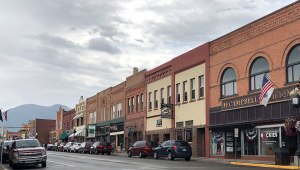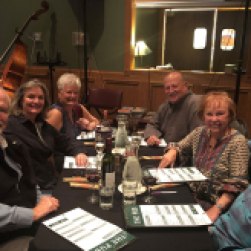You might drive right through the town of Red Lodge, Montana on your way to the northern gate of Yellowstone Park. That would be a mistake. Because Red Lodge is more than a mere gateway town: this historic town of 2300 souls is a destination in its own right, one you don’t want to miss if you’re headed out west.
During the first week of September, my husband, sister, and brother-in-law flew into Billings, Montana, rented an SUV, and drove into Red Lodge where we had reservations at the Pollard Hotel for two nights. Friends of ours who live there—even though they travel all over the world—had invited us to visit their charming hometown. We arrived at lunchtime and weren’t due to meet them until that evening. It was a sunny fall day, with rain expected the following day, so we decided to take the acclaimed Beartooth All American Road (Highway 212) to the famous Beartooth Pass. After all, Charles Kuralt from the television show On the Road had called the route “the most beautiful drive in America.” Why not check it out for ourselves? We purchased a Styrofoam cooler and sandwich fixings at a local supermarket and headed out to explore.
Taking the Beartooth Highway.
We’re climbing, and climbing, and climbing…! After stopping at a turnout for a photo-op at 8000’ elevation, we enter a series of switchbacks that take us over 1,500 feet in seven miles. Lush forests and pristine vistas rapidly change to twisted gray trees and alpine tundra. There’s a story behind those massive chain-link fences we’re seeing. In May of 2005, a week before the highway was scheduled to open, nine inches of rain fell in three days, causing a massive mudslide that tore down the canyon, dislodging more than 500,000 cubic tons of rock. The reconstruction effort that summer cost $20 million, the same amount (adjusted for inflation) that was spent to build the road in the 1930s.
About 20 miles into this adventure, we reach Vista Point Rest Area. As we leave the parking lot, we round a series of curves called the “Mae West curves,” after the buxom star of the 1930s. Reportedly, that descriptive sign was taken down because it was too risqué! After rounding those curves, we’re astonished by the expansive vista to our right called the “Hellroaring Plateau.” The road climbing that side of the valley covers the same elevation gain in half the miles, it’s unpaved and rocky, and there are no guardrails. Needless to say, we’re not going there!
After exactly 23.9 miles on Hwy 212, we spot the Welcome to Wyoming sign, reportedly the highest welcome sign in the U.S. This is also the 45th Parallel, meaning we’re now halfway between the North Pole and the equator. At 27 miles, we reach Beartooth Basin. Here you can ski at 10,000 feet during your summer vacation. Just check beartoothbasin.com for conditions. Thanks, but no thanks! Soon after the basin we spot the Gardner Lake pullout. What an incredible view of stunning cobalt-blue lakes set into undulating waves of rock! It’s an ideal setting for selfies, but you could die if you keep stepping back to get that perfect shot. We decide to take pics of our mates instead, yelling “smile but don’t move!”
Suddenly we realize that we must head back from here if we are to be back at our hotel in time to check in and enjoy the evening. On the way back, we stop again at the Vista Point rest area to enjoy our lunch.

Wayfinding on the Beartooth.
Historic Red Lodge.
The Pollard Hotel is fascinating. Built in 1893, this was the first brick building in town, cost $20,000 to build and had 35 rooms. A glass case in the sitting room displays and explains its history. Famous guests include William E. “Buffalo Bill” Cody, Martha “Calamity Jane” Cannary, and John “Liver-eatin” Johnston. Our friends Don and Rebecca join us for drinks and dinner. We have a marvelous time. Of course, they advise us what to see in their historic town the next day.
We spend the morning walking the town, beginning with the Carbon County Historical Society and Museum. In 1990, this three-story Labor Temple building was gifted to the Historical Society. It had been built in 1909 by the Red Lodge Miners Local No. 1771 and put on the National Register of Historic Places in 1983. The basement level contains an excellent interactive coal and hard rock mine exhibit. Afterward, we take the downtown walking tour, five blocks of Broadway lined with historic brick buildings on both sides: the Carbon County Courthouse, the Blackburn Building, the Red Lodge State Bank, and finally, the Carbon County Bank where Kid Curry and the Sundance Kid were reportedly captured after a foiled bank robbery. Before turning back we stop at a few art galleries and the old railroad terminal.

Broadway the main street of Red Lodge.
Driving through the Wilderness: the West Fork of Rock Creek.
We have the afternoon free, so we decide to take a self-guided sightseeing drive until the rain comes. At Gunter’s urging, John turns onto “the road less traveled” past the local Red Lodge ski area, the Girl Scout camp, and up into the wilderness. We have no idea where we are until we see a You Are Here sign. We’re at the West Fork of Rock Creek Trailhead in the million-acre Absoroka-Beartooth National Wilderness—one of the highest and most rugged areas in the lower 48 states. Yep! Gunter has a reputation for getting us into adventurous “situations.” But we’re here so we may as well…drive onwards. There must be more to see.
We’re all alone back here. We stop, park on the gravel road, and listen to the creek. No-one wants to break the silence, but occasionally we whisper to each other. Please take a minute to see what I saw and hear what I heard:
Rain clouds are forming and AAA might not want to rescue us here, so we hightail back to Red Lodge. We rest in our hotel while a soft rain drenches this town we have come to love. In the evening, our friends meet us in the hotel’s main dining room where they have made reservations to kick back and experience their favorite local band, The High Country Cowboys. What a way to conclude a memorable stay in this quaint-but-fun mountain town!
About the Author: Lois and Günter Hofmann lived their dream by having a 43-foot ocean-going catamaran built for them in the south of France and sailing around the world. Learn more about their travel adventures by reading Lois’s award winning nautical adventure trilogy. Read more about Lois and her adventures at her website and stay in touch with Lois by liking her Facebook page.












October 14, 2019 at 5:12 pm
What a wonderful adventure!
LikeLiked by 1 person
October 14, 2019 at 6:47 pm
Really interesting post.
LikeLiked by 1 person
October 17, 2019 at 3:13 pm
Delightful, Lois!! You and Gunter never cease to be eager explorers! Love and hugs, Joni
________________________________
LikeLiked by 1 person